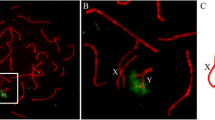Summary
A patient with azoospermia and a Y isochromosome is described. The breakpoint producing this i(Y) was within the terminal short arm of the Y chromosome. Lymphocyte cultures from peripheral blood contained a high proportion of 45,X cells and cells with different Y-chromosome rearrangements. The i(Y) had either a monocentric or dicentric appearance. In dicentrics, anti-kinetochore immunofluorescence was present at both centromeres. However, this was also true for most of the functional monocentrics (pseudodicentrics). Kinetochore staining was generally positive at the site of the inactive centromeres; only a minority of the suppressed centromeres had lost their antigenic properties. Permanently growing lymphoblasts consistently showed a monocentric i(Y) with only one fluorescing kinetochore; the immunonegative Y centromere did not recover antigenicity.
Similar content being viewed by others
References
Caspersson T, Zech L, Johansson C, Modest EJ (1970) Identification of human chromosomes by DNA-binding fluorescent agents. Chromosoma 30:215–227
Daniel A (1985) Y isochromosomes and rings. In: Sandberg AA (ed) The Y chromosome, part B: Clinical aspects of Y chromosome abnormalities. Liss, New York, pp 105–135
Davis RM (1981) Localisation of male determining factors in man: a thorough review of structural anomalies of the Y chromosome. J Med Genet 18:161–195
Earnshaw WC, Migeon BR (1985) Three related centromere proteins are absent from the inactive centromere of a stable isodicentric chromosome. Chromosoma 92:290–296
Earnshaw WC, Ratrie III H, Stetten G (1989) Visualization of centromere proteins CENP-B and CENP-C on a stable dicentric chromosome in cytological spreads. Chromosoma 98:1–12
Fryns JP, Kleczkowska A, Lemmens P, Berghe H van den (1987) Unusual in vivo rearrangements of the Y-chromosome in two males. Clin Genet 31:132–136
Haaf T, Schmid M (1988) Analysis of double minutes and double minute-like chromatin in human and murine tumor cells using antikinetochore antibodies. Cancer Genet Cytogenet 30:73–82
Haaf T, Schmid M (1989) Centromeric association and non-random distribution of centromeres in human tumour cells. Hum Genet 81:137–143
Harper ME, Saunders GF (1981) Localization of single copy DNA sequences on G-banded human chromosomes by in situ hybridization. Chromosoma 83:431–439
Merry DE, Pathak S, Hsu TC, Brinkley BR (1985) Anti-kinetochore antibodies: use as probes of inactive centromeres. Am J Hum Genet 37:425–430
Moroi Y, Peebles C, Fritzler MJ, Steigerwald J, Tan EM (1980) Autoantibody to centromere (kinetochore) in scleroderma sera. Proc Natl Acad Sci USA 77:1627–1631
Neitzel H (1986) A routine method for the establishment of permanent growing lymphoblastoid cell lines. Hum Genet 73:320–326
Peretti D, Maraschio P, Lambiase S, Lo Curto F, Zuffardi O (1986) Indirect immunofluorescence of inactive centromeres as indicator of centromeric function. Hum Genet 73:12–16
Pfeiffer RA (1974) Cell cultures from blood and bone marrow. In: Schwarzacher HG, Wolf U (eds) Methods in human cytogenetics. Springer, Berlin Heidelberg New York, pp 1–37
Rivera H, Zuffardi O, Maraschio P, Caiulo A, Anchini C, Scarinci R, Vivarelli R (1989) Alternate centromere inactivation in a pseudodicentric (15; 20) (pter; pter) associated with a progressive neurological disorder. J Med Genet 26:626–630
Schweizer D, Ambros P, Andrle M (1978) Modification of DAPI banding on human chromosomes by prestaining with a DNA binding oligopeptide antibiotic, distamycin A. Exp Cell Res 111:327–332
Sumner AT (1972) A simple technique for demonstrating centromeric heterochromatin. Exp Cell Res 75:304–306
Therman E, Trunca C, Kuhn EM, Sarto GE (1986) Dicentric chromosomes and the inactivation of the centromere. Hum Genet 72:191–195
Vianna-Morgante AM, Rosenberg C (1986) Deletion of the centromere as a mechanism for achieving stability of a dicentric chromosome. Cytogenet Cell Genet 42:119–122
Wandall A (1989) Kinetochore development in two dicentric chromosomes in man. A light and electron microscopic study. Hum Genet 82:137–141
Author information
Authors and Affiliations
Rights and permissions
About this article
Cite this article
Haaf, T., Schmid, M. Y isochromosome associated with a mosaic karyotype and inactivation of the centromere. Hum Genet 85, 486–490 (1990). https://doi.org/10.1007/BF00194221
Received:
Revised:
Issue Date:
DOI: https://doi.org/10.1007/BF00194221




